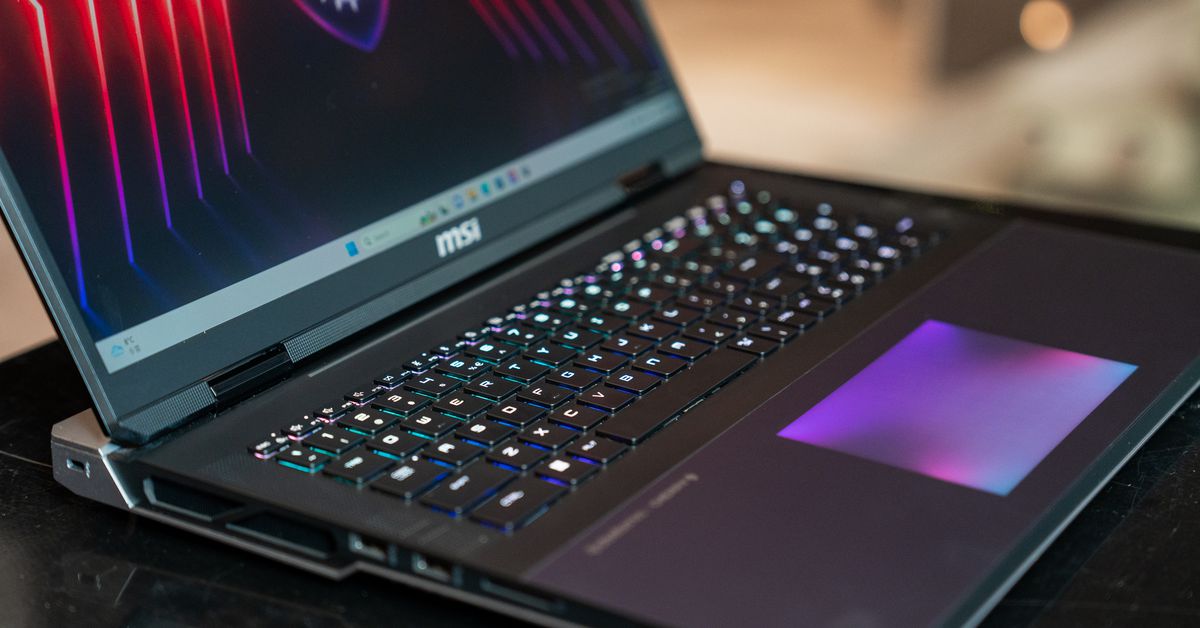What a weird title. They are completely 2 different, independent things. Just to be categorized with AI hype articles…
Also, one of these is a mere update hugging the tech plateau, the other is a disruptive hockey stick.
All news are for investors nowadays. Microinvestment runs the 2020s world.
Did it take off? How many people are rushing out right now to buy a gaming laptop so they can have the best wifi?
I hope not much some are decent and have swappable wifi modules. But not sure how common that is.
I guess one reason why no one is paying attention to it is because is the Wi-Fi speed usually the limiting factor? In my case I’ve rarely ever maxed out my Wi-Fi 6 speeds. Typically the host or the network that I’m on that is the limiting factor.
Although I’m also in the US so I know where not know for having the fastest internet in the world. Maybe in other areas of the world WiFi 7 might be more useful.
I’m more excited about reducing congestion when more of my neighbors upgrade to 6, so that BSS coloring and other wifi 6/7 features can enable more efficient use of the spectrum. Before wifi 6 most of the upgrades were just increasing data rates, but really lacking in improvements to spectral use efficiency (like the resource unit allocation in OFDMA which splits channels into sub carriers and centrally plans assignment to multiple client devices for simultaneous use which results in much less wasted airtime compared to each device yelling and listening while waiting to see if they can have exclusive access to the whole channel which wastes time) and interference management (like preamble puncturing which allows partial use of a channel when only a portion has interference). In a crowded environment like an apartment building wifi 6 should help a lot in reducing channel utilization.
Also the fact that the faster the wifi, the easier it is to block.
These new standards aren’t really targeting residential use so just people shouldn’t care.
Ok, I know why we changed the version naming scheme: a, b, g, n, ac, ax… It was a nightmare, just awful.
But I’ll bet it does still have a IEEE designation, so how does 6 or 7 map to the previous scheme? Also, what’s new, what are the impressive current speeds and features?
5 is AC, 6 is AX
How many of your devices actually support this?
The article is about how new products are getting support for Wifi 7, so probably none of your current devices.
My comment was more a rebuke at the headline than the article
Why would we have eyes on something that won’t be reasonably useful for years?
The boosted speed is also beneficial for mesh networks, not just end devices.
deleted by creator
That’s basically CES in a nutshell. Nearly everything shown off won’t be useful for years.
The headline seems to be targeted at dedicated Verge readers who know that AI is the current big buzzword at CES, they are likely a bit tired of it, and are interested in something that’s not AI.
Yeah, I just upgraded to a new laptop 18 months ago, it does WiFi 6 I think, the one that’s popular for the Quest 2 headset anyway, and this is going to be my computer now for at least another 8 years, like the last one was.
Same with the router, which I upgraded to get that newer WiFi, and now it’s going to sit there doing it’s job for probably the next decade, because it does it well.
Maybe in 2032 I’ll upgrade to WiFi 7, but there’s no real need to do so until then, unless something really important that WiFi 6 can’t handle comes along.
PowerShell 7 quietly took off while I was struggling with my IBS.
And when did decent mesh systems start costing $1K+?!?!
When they can transmit over 10gbps
I wish I had 10g into my house. Well maybe not, it would probably be VERY expensive
That doesn’t mean you couldn’t benefit from those LAN speeds.
It feels like the rollout of client modules and APs/routers was better synchronized this time. Back with wifi 6 I ordered the Intel modules within a week of them being available on AliExpress and then waited for what felt like months for APs to be available (it looks like unifi’s wifi 6 ap finally came out in November 2021 based on when I bought it). Unifi’s U7 pro dropped a few days ago so I nabbed one as soon as I saw the email and that arrived today so that’s already set up, and the wifi 7 modules have already been out for a bit, i just didn’t order them since I was anticipating a wait for APs. So now I just gotta wait a bit for shipping and I’ll have all my laptops upgraded too.
as a poor pc gamer runnin a 6700k i will see yall soon because this thing is getting crusty
My gaming PC doesn’t even have wifi, I just ran a cable. I wire everything I can, even my Chromecast using USB otg adapters. The less stuff that’s on the WiFi, the less crappy of an experience the stuff that’s left will have. Also I’m just about there with you, my non-work laptop is an almost 6 year old XPS 15 with a 7700k, but I swapped the wifi chip for an ax200ngw wifi 6 one for $15.
I literally just installed my unifi wifi6 pro a coupl weeks ago. …I had no idea WiFi 7 was just around the corner.
That said, non of my devices support that as far as I know so I am not going to be missing out for a while I don’t think.
It won’t be worth it for a hot minute. There are only a few routers on the market and they range from several hundred to a couple thousand.
And there are even fewer devices that support it. There are a couple laptops that support it, but they’re a few thousand dollars.
Sounds like the usual introduction for a new wifi protocol. It’s a niche market until enough devices become compatible. Then a rapid adoption as things reach their normal end-of-life and are replaced.
So wifi 7 will be widely adopted in 5-7 years if it proves stable.
Haha, you and me both. At least it probably won’t matter for a few years.
Where has it taken off ? Only a handful of routers are out for it and they are stupidly expensive. Are there even devices that can utilize wifi 7 ?
Maybe a flagship here and there and a high gaming computer
A lot of innovations in WiFi aren’t about having a better access point for home use.
Don’t care
Does anybody know if this will have actual security?
What do you mean? Wifi is already secured.
no both options are fundamentally insecure. the current standard 2 and the version 3 of wpa
ahh, i see what you are saying. You aren’t saying that WiFi is not secured, you are saying the security has been compromised.
https://web.archive.org/web/20151113152528/http://www.airtightnetworks.com/WPA2-Hole196
"the group temporal key (GTK) that is shared among all authorized clients in a WPA2 network. In the standard behavior, only an AP is supposed to transmit group-addressed data traffic encrypted using the GTK and clients are supposed to decrypt that traffic using the GTK. However, nothing in the standard stops a malicious authorized client from injecting spoofed GTK-encrypted packets! Exploiting the vulnerability, an insider (authorized user) can sniff and decrypt data from other authorized users as well as scan their Wi-Fi devices for vulnerabilities, install malware and possibly compromise those devices.
In short, this vulnerability means that inter-user data privacy among authorized users is inherently absent over the air in a WPA2-secured network. "
https://en.wikipedia.org/wiki/Wi-Fi_Protected_Access#Security_issues
" Predictable Group Temporal Key (GTK)
In 2016 it was shown that the WPA and WPA2 standards contain an insecure expository random number generator (RNG). Researchers showed that, if vendors implement the proposed RNG, an attacker is able to predict the group key (GTK) that is supposed to be randomly generated by the access point (AP). Additionally, they showed that possession of the GTK enables the attacker to inject any traffic into the network, and allowed the attacker to decrypt unicast internet traffic transmitted over the wireless network. They demonstrated their attack against an Asus RT-AC51U router that uses the MediaTek out-of-tree drivers, which generate the GTK themselves, and showed the GTK can be recovered within two minutes or less. Similarly, they demonstrated the keys generated by Broadcom access daemons running on VxWorks 5 and later can be recovered in four minutes or less, which affects, for example, certain versions of Linksys WRT54G and certain Apple AirPort Extreme models. Vendors can defend against this attack by using a secure RNG. By doing so, Hostapd running on Linux kernels is not vulnerable against this attack and thus routers running typical OpenWrt or LEDE installations do not exhibit this issue.[54] "
https://en.wikipedia.org/wiki/KRACK " The KRACK attack
believed to affect all variants of WPA and WPA2; however, the security implications vary between implementations, depending upon how individual developers interpreted a poorly specified part of the standard. Software patches can resolve the vulnerability but are not available for all devices.[57] KRACK exploits a weakness in the WPA2 4-Way Handshake, a critical process for generating encryption keys. Attackers can force multiple handshakes, manipulating key resets. By intercepting the handshake, they could decrypt network traffic without cracking encryption directly. This poses a risk, especially with sensitive data transmission.[58]"
Here’s the summary for the wikipedia article you mentioned in your comment:
KRACK ("Key Reinstallation Attack") is a replay attack (a type of exploitable flaw) on the Wi-Fi Protected Access protocol that secures Wi-Fi connections. It was discovered in 2016 by the Belgian researchers Mathy Vanhoef and Frank Piessens of the University of Leuven. Vanhoef's research group published details of the attack in October 2017. By repeatedly resetting the nonce transmitted in the third step of the WPA2 handshake, an attacker can gradually match encrypted packets seen before and learn the full keychain used to encrypt the traffic. The weakness is exhibited in the Wi-Fi standard itself, and not due to errors in the implementation of a sound standard by individual products or implementations. Therefore, any correct implementation of WPA2 is likely to be vulnerable. The vulnerability affects all major software platforms, including Microsoft Windows, macOS, iOS, Android, Linux, OpenBSD and others.The widely used open-source implementation wpa_supplicant, utilized by Linux and Android, was especially susceptible as it can be manipulated to install an all-zeros encryption key, effectively nullifying WPA2 protection in a man-in-the-middle attack. Version 2.7 fixed this vulnerability.The security protocol protecting many Wi-Fi devices can essentially be bypassed, potentially allowing an attacker to intercept sent and received data.









